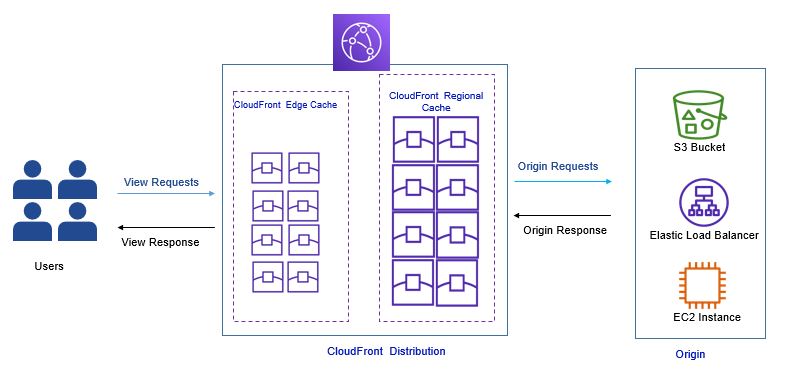Customer Use-Case : E-commerce Website with Global Customer Base
Velloxx Shop is a growing e-commerce company that sells products online to customers all over the world. Currently, they host their e-commerce website on AWS infrastructure located in the EU-Central region. As the company’s customer base expands, they face a significant challenge in delivering a fast and seamless shopping experience to users located in different regions. The current setup struggles to cope with the increasing traffic and global demand, leading to slower load times and reduced customer satisfaction.This challenge is worsened when Velloxx Shop does sales events and promotions. Also to optimize customer experience, Velloxx Shop wants to deliver personalized content to users in specific regions.
In this scenario, AWS CloudFront presents an ideal solution to address the business problem for Velloxx Shop. By implementing CloudFront as a content delivery network for their e-commerce website, Velloxx Shop can leverage its global network of edge locations strategically positioned across different regions to deliver fast and secure resources to their customers.
In this article, we will explore what AWS CloudFront is, why it is essential for modern businesses, how it addresses the challenges of Velloxx Shop, and pricing details. We will look at how to implement this and leverage its features in the next article.
1. What is AWS CloudFront?
AWS CloudFront is a globally distributed CDN service provided by Amazon Web Services which helps businesses improve the delivery of their content by caching data at edge locations located around the world. These edge locations are strategically positioned to be geographically closer to end-users, reducing latency and improving response times when accessing web content.This allows businesses like Velloxx Shop to securely delivers data, videos, applications, and APIs to customers globally with low latency and high transfer speeds
Amazon CloudFront supports content delivered via HTTP and WebSocket protocols, including dynamic web pages, static files (images, audio, video, and software), and live/on-demand media streaming over HTTP.
2. What is an Edge Location?
An edge location is just a data center where the cached content is stored. A collection of edge locations is called a distribution. CloudFront edge locations are not the same as AWS Availability Zones. AWS Availability Zones are isolated data centers within a specific AWS region, designed for redundancy and high availability. In contrast, CloudFront edge locations are geographically dispersed and focused on content delivery optimization.

Figure 1: CloudFront Distribution
The location where content is stored, and from which CloudFront gets content to serve to viewers is called the Origin.
3. Why should Velloxx Shop use CloudFront, and how does it address their challenge?
a. Faster Content Delivery: CloudFront caches static and dynamic content at its edge locations, reducing the round-trip time for data to travel from the origin to the end-user. When a customer in a specific region accesses Velloxx Shop’s e-commerce website, CloudFront serves the content from the nearest edge location, resulting in significantly faster load times and a seamless shopping experience.
b. Global Scalability: With CloudFront, Velloxx Shop can handle sudden traffic spikes during promotions, sales events, or peak shopping seasons. CloudFront’s automatic scaling and integration with other AWS services, such as Amazon S3 for storage and Elastic Load Balancing for distributing traffic, ensure that the website remains highly available and responsive under heavy loads.
c. Enhanced Security: CloudFront provides SSL/TLS encryption for data in transit, ensuring that Velloxx Shop’s customer information, including payment details, remains secure during the transaction process. Moreover, CloudFront’s integration with AWS Shield provides protection against Distributed Denial of Service (DDoS) attacks, safeguarding the website from potential threats.
d. Cost Optimization: CloudFront follows a pay-as-you-go pricing model, allowing Velloxx Shop to optimize costs based on actual usage. By caching content at edge locations, CloudFront reduces the load on the origin server, leading to lower operational costs associated with bandwidth and server capacity.
e. Personalized Content Delivery: CloudFront supports dynamic content delivery, enabling Velloxx Shop to deliver personalized product recommendations, pricing, and other dynamic elements to users based on their geographic location or preferences.
By implementing AWS CloudFront, Velloxx Shop can ensure a seamless, fast, and secure shopping experience for its global customer base. The improved website performance, scalability, and cost-effectiveness provided by CloudFront contribute to increased customer satisfaction, higher conversion rates, and ultimately, business growth.
4. CloudFront Pricing.
AWS CloudFront follows a flexible pay-as-you-go pricing model, allowing businesses to optimize costs based on actual usage.
CloudFront offers a free tier which includes the following:
- 1 TB of data transfer out to the internet per month
- 10,000,000 HTTP or HTTPS Requests per month
- 2,000,000 CloudFront Function invocations per month
- Free SSL certificates
- No limitations, all features available
AWS CloudFront charges depend on two main components: data transfers out from its edge locations, along with HTTP or HTTPS requests. Pricing also varies by usage type, geographical region, and feature selection.
a. Data Transfer Out: This refers to the amount of data served to end-users from the CloudFront edge locations. It includes both HTTP and HTTPS requests. AWS CloudFront follows a tiered pricing model, where the cost per gigabyte decreases as the data transfer volume increases. The cost depends on the specific region where the content is delivered from and the volume of data transferred.
b. HTTP/HTTPS Requests: CloudFront charges for the number of requests made to the CDN, which includes both viewer and invalidation requests. Similar to data transfer out, the cost per request decreases as the number of requests increases.
To calculate the exact pricing and for more details on pricing, kindly refer to the AWS CloudFront pricing page.